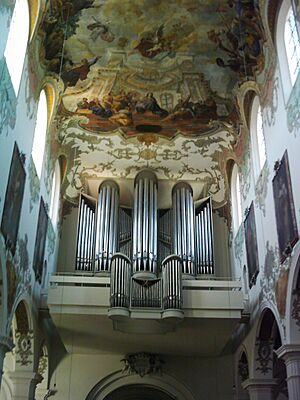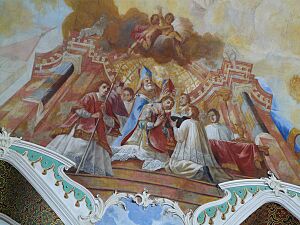Johannes Zick facts for kids
Quick facts for kids
Johannes Zick
|
|
|---|---|
| Born | 10 January 1702 |
| Died | 4 March 1762 (aged 60) |
| Other names | Johann Zick |
| Known for | Painting |
Johannes Zick (born January 10, 1702 – died March 4, 1762) was a very talented German painter. He was famous for his amazing frescoes, which are paintings done on wet plaster. Johannes Zick worked in southern Germany during the Baroque period. This was a time when art was very grand and dramatic.
He was the father of another famous painter, Januarius Zick. Johannes Zick is seen as a very important artist from the Late Baroque era.
Contents
Johannes Zick's Life Story
Johannes Zick was born in 1702 in a place called Lachen. This area is now part of Bavaria. He started his career working as a blacksmith in his father's shop.
From 1721 to 1724, Johannes learned painting from Jacob Carl Stauder. Stauder was a court painter in Konstanz. Together, they painted beautiful frescoes on the ceiling of the Mariahilf church in Munich.
Moving to Munich
In 1728, Zick and his family moved to Munich. There, he became a court painter for Johann Theodor of Bavaria. This was a very important job. Johannes Zick learned a lot from the Asam brothers, who were also famous artists in Munich at that time. They helped him become even better at painting frescoes.
Painting in Upper Swabia
Between 1744 and 1749, Johannes Zick worked a lot in a region called Upper Swabia. His family moved there in 1746. They lived in either Schussenried or Biberach an der Riß.
In 1746, he painted the frescoes on the ceiling of the main part of St. Martin's Church in Biberach an der Riß. He also designed how other parts of the church would be rebuilt and painted in 1747.
Later Years and Important Works
Around 1750, Johannes Zick moved to Würzburg. There, he painted frescoes in the garden room of the Würzburg Residence. This was where the Prince Bishop of Würzburg lived.
For nine years, from 1751 to 1759, he created many paintings for the residence of the Prince Bishops of Speyer in Bruchsal. Johannes Zick passed away in Würzburg in 1762.
Some of His Famous Artworks
Johannes Zick created many amazing artworks throughout his life. Here are some of the places where you can find his paintings:
- 1736 – He decorated the vault and altar in the church of St. John the Baptist, Bergkirchen.
- 1737 – He painted frescoes in the Roßacker Chapel in Rosenheim.
- 1738/1739 – You can see his frescoes in St. George's church in Raitenhaslach.
- 1740/1742 – He painted five altarpieces for the collegiate church St. Andrews, Berchtesgaden.
- 1745/1746 – He created frescoes in the Premonstratensian abbey church St. Magnus, Schussenried.
- 1746/1747 – He painted frescoes and decorations in the church of St. Martin, Biberach an der Riß.
- 1749/1750 – He made frescoes for the garden-room at the Würzburg Residence.
- 1751-1759 – He painted many frescoes at the residence in Bruchsal.
- 1753 – He created paintings in the Amorbach parish church.
- 1755 – He painted in the refectory (dining hall) of Monastery Oberzell near Würzburg.
- 1756 – He made paintings for the Sandkirche, Aschaffenburg.
- 1757 – He painted in the Grafenrheinfeld parish church.
See also
- Upper Swabian Baroque Route
- Zick




